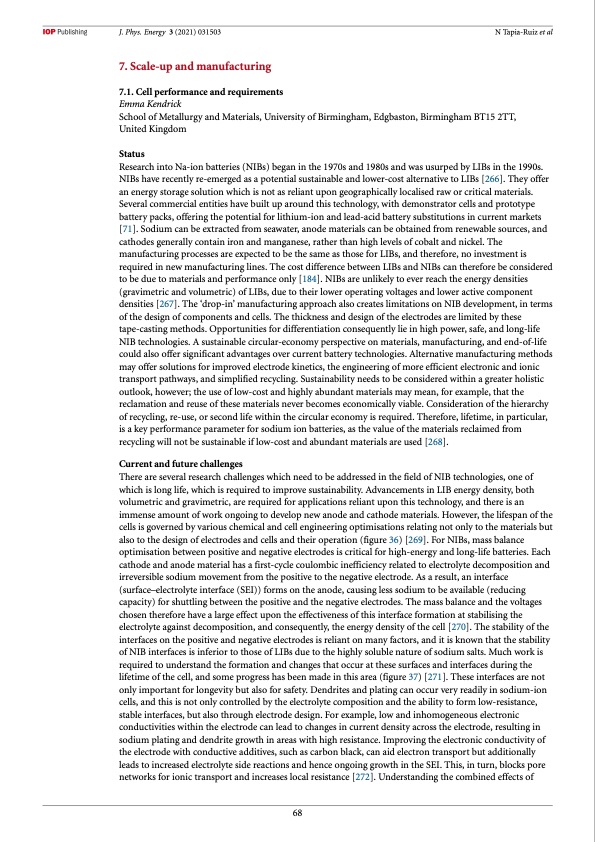
PDF Publication Title:
Text from PDF Page: 069
J. Phys. Energy 3 (2021) 031503 N Tapia-Ruiz et al 7. Scale-up and manufacturing 7.1. Cell performance and requirements Emma Kendrick School of Metallurgy and Materials, University of Birmingham, Edgbaston, Birmingham BT15 2TT, United Kingdom Status Research into Na-ion batteries (NIBs) began in the 1970s and 1980s and was usurped by LIBs in the 1990s. NIBs have recently re-emerged as a potential sustainable and lower-cost alternative to LIBs [266]. They offer an energy storage solution which is not as reliant upon geographically localised raw or critical materials. Several commercial entities have built up around this technology, with demonstrator cells and prototype battery packs, offering the potential for lithium-ion and lead-acid battery substitutions in current markets [71]. Sodium can be extracted from seawater, anode materials can be obtained from renewable sources, and cathodes generally contain iron and manganese, rather than high levels of cobalt and nickel. The manufacturing processes are expected to be the same as those for LIBs, and therefore, no investment is required in new manufacturing lines. The cost difference between LIBs and NIBs can therefore be considered to be due to materials and performance only [184]. NIBs are unlikely to ever reach the energy densities (gravimetric and volumetric) of LIBs, due to their lower operating voltages and lower active component densities [267]. The ‘drop-in’ manufacturing approach also creates limitations on NIB development, in terms of the design of components and cells. The thickness and design of the electrodes are limited by these tape-casting methods. Opportunities for differentiation consequently lie in high power, safe, and long-life NIB technologies. A sustainable circular-economy perspective on materials, manufacturing, and end-of-life could also offer significant advantages over current battery technologies. Alternative manufacturing methods may offer solutions for improved electrode kinetics, the engineering of more efficient electronic and ionic transport pathways, and simplified recycling. Sustainability needs to be considered within a greater holistic outlook, however; the use of low-cost and highly abundant materials may mean, for example, that the reclamation and reuse of these materials never becomes economically viable. Consideration of the hierarchy of recycling, re-use, or second life within the circular economy is required. Therefore, lifetime, in particular, is a key performance parameter for sodium ion batteries, as the value of the materials reclaimed from recycling will not be sustainable if low-cost and abundant materials are used [268]. Current and future challenges There are several research challenges which need to be addressed in the field of NIB technologies, one of which is long life, which is required to improve sustainability. Advancements in LIB energy density, both volumetric and gravimetric, are required for applications reliant upon this technology, and there is an immense amount of work ongoing to develop new anode and cathode materials. However, the lifespan of the cells is governed by various chemical and cell engineering optimisations relating not only to the materials but also to the design of electrodes and cells and their operation (figure 36) [269]. For NIBs, mass balance optimisation between positive and negative electrodes is critical for high-energy and long-life batteries. Each cathode and anode material has a first-cycle coulombic inefficiency related to electrolyte decomposition and irreversible sodium movement from the positive to the negative electrode. As a result, an interface (surface–electrolyte interface (SEI)) forms on the anode, causing less sodium to be available (reducing capacity) for shuttling between the positive and the negative electrodes. The mass balance and the voltages chosen therefore have a large effect upon the effectiveness of this interface formation at stabilising the electrolyte against decomposition, and consequently, the energy density of the cell [270]. The stability of the interfaces on the positive and negative electrodes is reliant on many factors, and it is known that the stability of NIB interfaces is inferior to those of LIBs due to the highly soluble nature of sodium salts. Much work is required to understand the formation and changes that occur at these surfaces and interfaces during the lifetime of the cell, and some progress has been made in this area (figure 37) [271]. These interfaces are not only important for longevity but also for safety. Dendrites and plating can occur very readily in sodium-ion cells, and this is not only controlled by the electrolyte composition and the ability to form low-resistance, stable interfaces, but also through electrode design. For example, low and inhomogeneous electronic conductivities within the electrode can lead to changes in current density across the electrode, resulting in sodium plating and dendrite growth in areas with high resistance. Improving the electronic conductivity of the electrode with conductive additives, such as carbon black, can aid electron transport but additionally leads to increased electrolyte side reactions and hence ongoing growth in the SEI. This, in turn, blocks pore networks for ionic transport and increases local resistance [272]. Understanding the combined effects of 68PDF Image | 2021 roadmap for sodium-ion batteries

PDF Search Title:
2021 roadmap for sodium-ion batteriesOriginal File Name Searched:
roadmap-sodium-ion-batteries_031503.pdfDIY PDF Search: Google It | Yahoo | Bing
Salgenx Redox Flow Battery Technology: Salt water flow battery technology with low cost and great energy density that can be used for power storage and thermal storage. Let us de-risk your production using our license. Our aqueous flow battery is less cost than Tesla Megapack and available faster. Redox flow battery. No membrane needed like with Vanadium, or Bromine. Salgenx flow battery
| CONTACT TEL: 608-238-6001 Email: greg@salgenx.com | RSS | AMP |